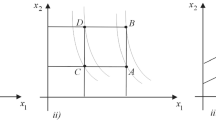Abstract
Very often in decision problems with uni- or multivariate objective, many results depend upon the signs of successive direct or cross derivatives of the utility function at least up to the 4th order. The purpose of the present paper is to provide a new and unified interpretation of these signs. It is based on the observation that decision-makers like to combine assets the return of which are negatively correlated (i.e., they have a preference for hedging). More specifically, this attitude is modelled through the concept of an “elementary correlation increasing transformation” defined by Epstein and Tanny (Can. J. Econ. 13:16–34, 1980). Decision-makers are said to be correlation averse if they dislike such a transformation. It will be shown that correlation aversion underlies many aspects of a decision-maker’s behavior under risk, including risk aversion, prudence, and temperance. Hence, correlation aversion provides a unifying, elegant and powerful framework to analyze risky decisions in the bivariate case. In this framework, also the concave version of the bivariate stochastic orderings introduced in Denuit, Lefèvre and Mesfioui (Insur. Math. Econ. 24:31–50, 1999a) turns out to be appropriate for comparing correlated outcomes and for comparing bivariate distributions with ordered marginals. The main result of this paper states that a decision-maker who is averse to correlation would rank bivariate outcomes as if using such higher order concave stochastic orderings. In particular, some features of decision-making under bidimensional risk, such as cross-prudence and cross-temperance, can also be linked to correlation aversion.
Similar content being viewed by others
References
Atkinson, A. B., & Bourguignon, F. (1982). The comparison of multi-dimensional distributions of economic status. Review of Economic Studies, 49, 183–201.
Chiu, W. H. (2005). Skewness preference, risk aversion and the precedence relations on stochastic changes. Management Science, 51, 1816–1828.
Denuit, M., & Eeckhoudt, L. (2008). Bivariate stochastic dominance and common preferences of decision-makers with risk independent utilities (Working Paper 08-03). Institut des Sciences Actuarielles, Université Catholique de Louvain, Louvain-la-Neuve, Belgium.
Denuit, M., Lefèvre, Cl., & Shaked, M. (1998). The s-convex orders among real random variables, with applications. Mathematical Inequalities and Their Applications, 1, 585–613.
Denuit, M., Lefèvre, Cl., & Mesfioui, M. (1999a). A class of bivariate stochastic orderings with applications in actuarial sciences. Insurance: Mathematics and Economics, 24, 31–50.
Denuit, M., De Vijlder, F. E., & Lefèvre, Cl. (1999b). Extremal generators and extremal distributions for the continuous s-convex stochastic orderings. Insurance: Mathematics and Economics, 24, 201–217.
Doherty, N., & Schlesinger, H. (1983). Optimal insurance in incomplete markets. Journal of Political Economy, 91, 1045–1054.
Drèze, J., & Modigliani, F. (1972). Consumption decision under uncertainty. Journal of Economic Theory, 5, 308–335.
Eeckhoudt, L., & Schlesinger, H. (2006). Putting risk in proper place. American Economic Review, 96, 280–289.
Eeckhoudt, L., Rey, B., & Schlesinger, H. (2007). A good sign for multivariate risk taking. Management Science, 53, 117–124.
Ekern, S. (1980). Increasing nth degree risk. Economics Letters, 6, 329–333.
Engelbrecht, R. (1977). A note on multivariate risk and separable utility functions. Management Science, 23, 1143–1144.
Epstein, L. G., & Tanny, S. M. (1980). Increasing generalized correlation: A definition and some economic consequences. Canadian Journal of Economics, 13, 16–34.
Fagart, M. C., & Sinclair-Desgagné, B. (2007). Ranking contingent monitoring systems. Management Science, 53, 1501–1509.
Fishburn, P. C. (1976). Continua of stochastic dominance relations for bounded probability distributions. Journal of Mathematical Economics, 3, 295–311.
Fishburn, P. C. (1980). Stochastic dominance and moments of distributions. Mathematics of Operations Research, 5, 94–100.
Gollier, C., & Pratt, J. (1996). Risk vulnerability and the tempering effect of background risk. Econometrica, 64, 1109–1123.
Kimball, M. S. (1990). Precautionary savings in the small and in the large. Econometrica, 58, 53–73.
Kimball, M. S. (1992). Precautionary motives for holding assets. In P. Newman, M. Milgate, & J. Falwell (Eds.), New palgrave dictionary of money and finance (Vol. 3, pp. 158–161). London: MacMillan.
Kimball, M. S. (1993). Standard risk aversion. Econometrica, 61, 589–611.
Menezes, C., & Wang, X. (2005). Increasing outer risk. Journal of Mathematical Economics, 41, 875–886.
Menezes, C., Geiss, C., & Tressler, J. (1980). Increasing downside risk. American Economic Review, 70, 921–932.
O’Brien, G. (1984). Stochastic dominance and moment inequalities. Mathematics of Operations Research, 9, 475–477.
Popescu, I. (2007). Robust mean covariance solution for stochastic optimization and applications. Operations Research, 55, 98–112.
Pratt, J., & Zeckhauser, R. (1987). Proper risk aversion. Econometrica, 55, 143–154.
Richard, S. (1975). Multivariate risk aversion utility independence and separable utility functions. Management Science, 22, 12–21.
Rolski, T. (1976). Order relations in the set of probability distribution functions and their applications in queueing theory. Dissertationes Mathematicae, 132, 5–47.
Tchen, A. H. (1980). Inequalities for distributions with given marginals. Annals of Probability, 8, 814–827.
Author information
Authors and Affiliations
Corresponding author
Rights and permissions
About this article
Cite this article
Denuit, M., Eeckhoudt, L. & Rey, B. Some consequences of correlation aversion in decision science. Ann Oper Res 176, 259–269 (2010). https://doi.org/10.1007/s10479-008-0446-7
Published:
Issue Date:
DOI: https://doi.org/10.1007/s10479-008-0446-7



